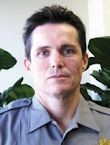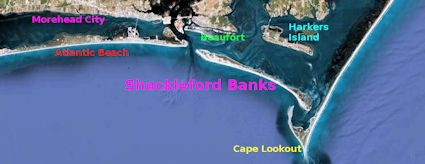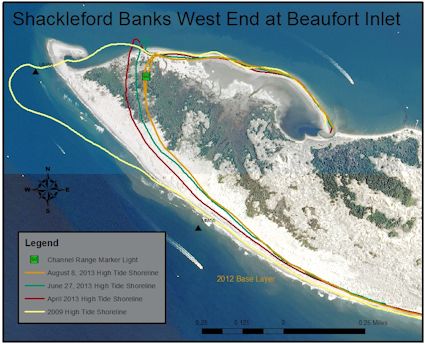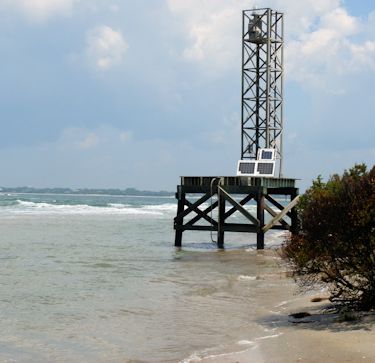Comment on PlanA public meeting on the Army Corps of Engineer’s “Draft Integrated Dredged Material Management Plan” and the accompanying environmental impact statement will be 6 p.m. to 8 p.m. today in the auditorium at the Duke Marine Lab on Pivers Island near Beaufort. The Corps will only accept written comments at the meeting. Supporter SpotlightWritten comments can also be sent to Hugh Heine at the Environmental Resources Sector, Army Corps of Engineers, Wilmington District, 69 Darlington Ave., Wilmington 28403. Comments will be accepted until Feb. 3. |
BEAUFORT – The latest skirmish in the ongoing Sand Wars is being waged on unfamiliar terrain and pits a new opponent against an unusual alliance of adversaries.
Though the first shots have already been fired, it all breaks out in the open 6 p.m. today at a public meeting at the Duke Marine Lab on Pivers Island over a proposed federal dredging plan for the Morehead City harbor.
Supporter Spotlight
 Pat Kenney |
For all the billions of grains of silica along the 320 miles of N.C. coastline, getting quality sand to widen beaches so as to protect the buildings along them from erosion, storms and a rising sea is maddingly difficult and frighteningly expensive. Once that sand is found, people then tend to fight over it. Seaside squabbles over who gets that sand and who pays for it have erupted over a wide front, from the mouth of the Cape Fear to the wind-swept strands of the Outer Banks. Combatants have included beach town mayors, federal engineers, taxpayers, scientists, bird lovers and turtle watchers.
The newest fight was ignited, as these things often are, by the Army Corps of Engineers, which has proposed a new 20-year dredging plan for the Morehead City harbor, Beaufort Inlet and the channel that connects the two. The Corps has been dredging these places for more than a century. Since 1986, it has used some of the resulting sand to widen the beach at nearby Atlantic Beach in order to protect the houses, hotels and roads of one of the oldest beach towns in North Carolina.
The relationship between the Corps and the town and Carteret County has had its ups and downs over the years, but everybody was more or less happy with the current arrangement. Then, the Corps released a draft of its new plan late last year. It proposes for the first time placing sand from the channel dredging, not only on Atlantic Beach, but also across the inlet on Shackleford Banks.
Part of Cape Lookout National Seashore, Shackleford is 19 miles of nothing – no houses, no roads, no motels, no condos, no people. It’s what makes the island so special. It has gorgeous sand dunes, ancient maritime forests with gnarled live oaks, deserted beaches, a herd of wild horse and a colorful history that includes the famed whaling port of Diamond City.
The western end of the island that abuts the inlet also has an erosion rate that in recent years has exceeded more than 100 feet a year, according to county surveys. Marine navigation lights that a few years ago were in the dunes are now at the water’s edge.
 The map shows Shackleford Banks in relationship to Morehead City and Atlantic Beach. |
 The survey of the west end of Shackleford Banks shows the location of the shoreline at high tide in 2009 (yellow line), in April 2013 (red), in June 2013 (green) and in August 2013 (orange). The green square is the location of the range marker light. Source: NPS |
Pat Kenney doesn’t think he can just sit idly by and watch the end of an island he’s charged to protect wash into the ocean. “We’re not taking this decision lightly,” said Kenney, the superintendent of the seashore. “But as managers, we’re always looking for options. You hate to walk away from any option you may need in the future.”
That’s why the National Park Service, which manages the seashore, asked the Corps in 2010 to include Shackleford in its long-range dredging plan. The Corps agreed and made Shackleford part of its preferred alternative, suggesting that about 40 percent of the sand dredged from the channel be placed there. The park, the plan notes, has the option of refusing when the time comes.
No decision has been made on whether the sand would actually be used, Kenney maintained. “But if we’re not included in this process it could be 20 years before we get another opportunity,” he said.
Having another possible suitor for the sand triggers jitters across the inlet in Atlantic Beach, which has come to depend on dredged sand. Pipes from the Corps’ dredging in 2011 spewed about 1.2 million cubic yards of sand from the state park at Fort Macon at the tip of Atlantic Beach to the Circle in the middle of town. That’s about 200,000 dump truck loads. About 600,000 cubic yards are scheduled to be spread along the town’s beach this year.
Trace Cooper, the mayor of Atlantic Beach, admits that he’s in this fight for selfish reasons. “This is a fight about sand,” he said. “My role as mayor is to protect the homes at Atlantic Beach and make sure we have good beaches for tourists. I think there’s a distinction between protecting a fully developed island and one that’s managed as a national wildlife area.”
Greg “Rudi” Rudolph, as manager of the county’s Shore Protection Office, is a seasoned sand warrior. He doesn’t relish picking a fight with a national park, but there’s big money involved. The county, Rudolph explained, is devising a beach re-nourishment plan for Atlantic Beach and all the other towns on Bogue Banks. That plan assumes that the Corps’ dredged sand will fortify much of Atlantic Beach. If even 40 percent of it goes someplace else, he said, the county will have to make up the shortfall. That will cost millions of dollars, Rudolph said. “We’d be screwed,” he said. “It would wreak havoc with our engineering and economics.”
The county and Atlantic Beach now pay next to nothing for the sand.
 Trace Cooper |
“We don’t want to make Shackleford Banks the red herring just to cover our butts,” Rudolph said, “but at the end of the day this is about saving our butts.”
With so much at stake, the town and county have gone on an early offensive. Lawyers have been hired and a public relations campaign launched with its obligatory web site. Mailings have been sent out, and “Keep Shack Wild” signs have sprouted up along roadsides and are particularly prevalent along U.S. 70 and Harkers Island Road in the eastern end of the county. Kenney thinks they were put there for his benefit. He drives the roads every day from his home in Beaufort to the park’s headquarters at the end of Harkers Island.
Opponents of the Corps’ plan have also reached out to unlikely allies. They’ve put aside old differences with scientists who have been critical of re-nourishment projects on Bogue Banks in the past and urged them to speak out against the plan.
“It’s not really our place to speak to the natural resource issues on Shackleford,” Rudolph explained a little sheepishly. “So we have asked others who are more knowledgeable.”
Certainly the most famous of these strange bedfellows is Orrin Pilkey. The esteemed geology professor at Duke University is an old war horse who has railed for decades against over-development of the state’s beaches. He led media tours in 2005 of a botched re-nourishment project that littered a section of Atlantic Beach in mud balls.
Pilkey appreciates the irony of now coming to the town’s defense, but his love of Shackleford, where he has led hundreds of graduate students on spirited jaunts through the dunes and along the beach, demands it.
“I’m very distressed by the plan,” he said. “This is very serious because we see the park service backing away from its very courageous policy of letting nature have its way.”
 The navigational range finder that was in the sand dunes at the tip of Shackleford Banks a few years ago is now in the water. Photo: NPS |
The Keep Shack Wild web site also makes much of this apparent backpedaling. They are all talking here of Section 4.8.1.1 of the 2006 park service policies regarding shorelines and barrier islands. It says:
“Natural shoreline processes (such as erosion, deposition, dune formation, overwash, inlet formation, and shoreline migration) will be allowed to continue without interference. Where human activities or structures have altered the nature or rate of natural shoreline processes, the Service will, in consultation with appropriate state and federal agencies, investigate alternatives for mitigating the effects of such activities or structures and for restoring natural conditions…”
The park service, Kenney said, maintains that the accelerated erosion at the tip of Shackleford isn’t natural. “There is science to support the contention that the erosion rate at the end of the island is due to the dredging of the inlet,” he said. “That’s why we want to be considered.”
Rudolph, a geologist himself, doesn’t disagree. Shackleford, he speculates, has continued its slow migration south and west, as barrier islands along our coast tend to do. Its western tip is now at the edge of the deep shipping channel maintained by the Corps. It has nowhere to go but in the ditch, Rudolph said.
The Corps recognizes that reality by proposing to put the dredged sand not on the island’s tip where it would quickly disappear but farther up the beach or just offshore. In theory, natural currents would then move the sand towards the end of the island.
“But depositing sand on Shackleford doesn’t solve the problem,” Rudolph says. “Nothing in the plan addresses the ultimate cause of the erosion.”
Pilkey isn’t so sure that dredging is the culprit. “It is absolutely normal. The inlet goes back and forth. What we’re seeing is typical,” he said. “Yeah, so the range finders are almost in the water. So what?”
Charles “Pete” Peterson would ask the same question. He is a researcher and biologist at the University of North Carolina’s Institute of Marine Sciences in Morehead City. A resident of Bogue Banks, Peterson was vocal in his criticism of re-nourishment projects a decade ago that dumped what he thought was inferior sand on the island’s beaches.
 Pete Peterson |
Putting sand – even the good stuff – on Shackleford provides no natural benefits, he said. Allowing the island’s end to erode – even if dredging is the ultimate cause – would.
“Two wrongs don’t make a right, and the cure is likely worse than the disease,” Peterson said. “That end of Shackleford is a breeding area for shore birds, and it still has active, healthy dunes. Having that as a mobile point is providing habitats. It would allow shoals to form where birds feed. It represents critical habitat that we don’t have much of. It forms a unique complex. That system as a whole is more valuable than the separate parts.”
Kenney concedes that those are all good points that will be considered during the public review process. “That’s why we have this process,” he said, “but understand that I’m not trying to counter the loss of little bits and pieces of the island. I’m trying to hang on to an option for a future I don’t know.”
Gird for fight, then, Rudolph warns. “It is Sand Wars,” he said. “It’s about winning and losing at the end of the day. And we will bring all our resources to bear.”








